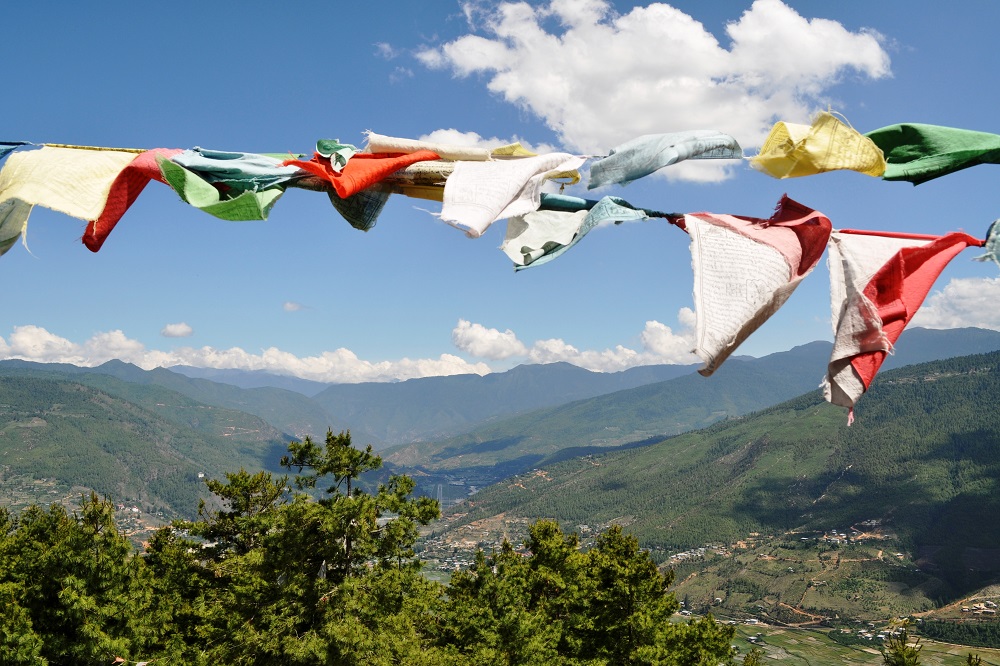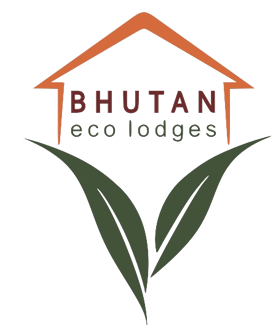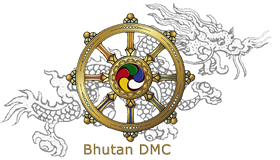Bhutan - The Himalayan Wonderland
This journey captures the amazing essence of Himalayan Wonderland & offers deep insights into the culture and traditions of the local people
Duration: 7 Nights 8 Days
Places Visited: Places Visited: Thimphu, Punakha across scenic Dochu la, Wangduephodrang, Gangtey & Phobjikha valley, Paro including hike to Tiger’s Nest, Chele la & Dzongdrakha Goempa (Mini Tiger’s Nest) & Haa Valley day excursion
Best Seasons to Visit: March to May & September to early December
Moderate Seasons to Visit: January, February, June to August & Late December
Trip Grade: Easy to fairly moderate (Involves long optional hikes)
Tour Type/Group Size: Private tour of you and your friends and families only
Special Notes: Itinerary can be fine-tuned depending on your interests
Day 1: Arrive Paro (Bhutan) by Flight & transfer to Thimphu (55km, approx. 1.1/2-hour drive)
The flight to Paro is one of the most spectacular in entire Himalayas. Flying along the Himalayan range from Kathmandu or over Himalayan foothills if flying from Kolkata, the journey offers fascinating views and an exciting descent into the Kingdom. Bhutan’s first gift to you as you disembark from the aircraft will be cool, clean fresh mountain air.
After immigration formalities and baggage collection you will be welcomed by our representative and embark on a picturesque drive to Thimphu, the capital town of Bhutan. The road leads through the Paro valley to the confluence of Paro and Thimphu rivers at Chuzom (confluence).
Shortly before reaching Chuzom, you will see on your left Tamchog Lhakhang, the temple built by Thangtong Gyalpo, a pioneering engineer who introduced the construction of suspension bridges into Bhutan and Tibet (several of which are still in use today). The present bridge to Tamchog Lhakhang was restored in 2005 in the design of a traditional style with iron chains and crossing this iron bridge is a wonderful experience.
On arrival, in Thimphu check-into the hotel. The capital town of Bhutan and the centre of government, religion and commerce, Thimphu is a unique city with unusual mixture of modern development alongside ancient traditions. It is perhaps still the world’s only capital city without a traffic light.
Later in afternoon walk around National Memorial Chorten, a large white structure crowned with a golden spire. It is located close to the center of Thimphu city and is one of its most iconic monuments. This is the most ideal spot to interact with locals who throng in large numbers to circumambulate the chorten, whirl the large red prayer wheels and pray at a small shrine inside the gate. The paintings and statues inside the monument provide a deep insight into Buddhist philosophy.
Afterwards an exploratory walk around Thimphu main street and market area.
Overnight at the hotel in Thimphu (Altitude 2,320m).
Day 2: Thimphu
Morning after breakfast, drive to see the iconic gigantic Buddha Dordenma (Vajra seated), the world’s largest sitting bronze statue. Majestically situated at Kuenselphodrang, it is an object of great veneration to all sentient beings. The land at Kuenselphodrang measuring 145 acres was gifted to Monks Body by His Majesty the Fourth King of Bhutan. The Park conserves 798.4 acres of forest area that surrounds the Buddha Dordenma statue. Dedicating it to the 60th birth anniversary celebration of His Majesty the Fourth Druk Gyalpo, His Holiness the Je Khenpo consecrated the 201 feet tall Buddha Dordenma statue at the Kuenselphodrang on 24th September 2015.
After this insightful visit drive to Textile Museum, established in 2001 under the royal patronage of Her Majesty Gyalyum Sangay Choden Wangchuck. The museum is managed by the Department of Culture, Ministry of Home & Cultural Affairs, Royal Government of Bhutan. Exhibitions here introduce the major weaving techniques, styles of local dress and textiles made by women and men.
Institute for Zorig Chusum, commonly known as Arts & Crafts School or Painting School is an important learning center that offers a six-year course on the 13 traditional arts and crafts of Bhutan. On a visit, one can see students learning the various skills taught at the school.
Located below the main town, Centenary Farmers Market popularly known as Weekend market is a pleasant, colorful & delightful place to mingle with locals. Farmers come from all over the country to sell their farm products in this market. Also available here are the handicrafts and artifacts, to purchase.
Then visit Changangkha Lhakhang, one of the ancient temples in Thimphu established on a site chosen by Phajo Drukgom Shigpo, the founder of Drukpa lineage in Bhutan. The central statue here is Chenrezig in a manifestation with 11 heads. From temple courtyard, there is fascinating view of Thimphu valley.
Conclude the sightseeing of the day with visit of Trashichhoedzong that has been the seat of the government since 1952 and presently houses the throne room and offices of His Majesty the King, the Secretariat and the Ministries of Home affairs and Finance. The dzong is located close to Thimphu town, next to the banks of the Wang Chhu River. It is an impressively large structure, surrounded by well-kept lawns and beautiful gardens.
Evening free to explore the government-run Handicrafts Emporium and local crafts Bazaar, to browse through example of Bhutan's fine traditional arts constituting hand-woven textiles, thangkha paintings, masks, ceramics, slate and wood carvings, jewellery, interesting items made from local materials.
Overnight at the hotel in Thimphu (Altitude 2,320m)
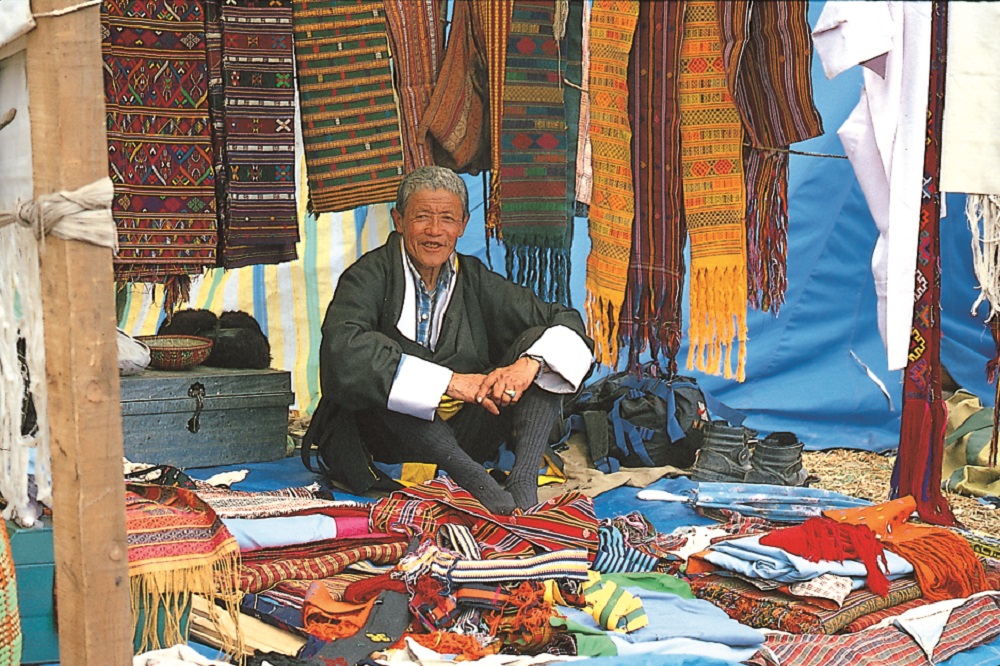
Day 3: Thimphu – Punakha & Wangduephodrang (75 km, approx. 3 hours drive)
After breakfast, drive to Punakha / Wangduephodrang across Dochu La. Located at a height of 3,088m/ 10,130 ft, Dochula is a scenic location with chorten, mani wall, and prayer flags which decorate this highest point on the road. If skies are clear, you can see the following peaks from this pass in the order left to right: Masagang (7,158m), Tsendagang (6,960m), Terigang (7,060m ), Jejegangphugang (7,158 m), Kangphugang (7,170 m ), Zongphugang (7, 060 m ), a table mountain that dominates the isolated region of Lunana - finally Gangkar puensum, the highest peak in Bhutan at 7,497m.
Afternoon visit Punakha Dzong or (Palace of Great Happiness), built in 1637 by Shabdrung Ngawang Namgyal, at the junction of the Phochu and Mochu rivers. This majestic dzong served as both the religious and the administrative centre of Bhutan in the past. It measures some 600 by 240 feet and has a six-story, gold-domed tower. Inside are courtyards and religious statuary that hint at the depth of history and spiritual tradition embodied here. Your guide will illuminate your understanding of this intricate culture that is exotic to us, though long established here.
Later in the day excursion to Chimi Lhakhang.
The Chimi Lhakhang, situated on a hillock in the centre of the valley, is also known as the temple of fertility. It is widely believed that couples who do not have children and wanting one, if they pray at this temple, they are usually blessed with a child very soon. A walk through the village near the temple will give you rare glimpses into the daily life and lifestyle of the villagers.
Overnight at the hotel in Punakha / Wangduephodrang . (Altitude 1,300m)
Day 4: Drive to Gangtey / Phobjikha (75 km, approx. 3 hours drive)
After breakfast, drive to Phobjikha / Gangtey. The valley of Gangtey is one of the most beautiful spots in Bhutan. The surprise of finding such a wide, flat valley without any trees after the hard climb through dense forests is augmented by an impression of vast space, and extremely rare experience in Bhutan where most of the valley’s are tightly enclosed.
Upon arrival check into hotel & later proceed to visit Gangtey Goempa, perched on a small hill that rises from the valley floor, the Gangtey Monastery is the only Nyingmapa monastery on the western side of the Black Mountain’s and also the biggest Nyingmapa monastery in Bhutan. The Monastery is surrounded by a large village inhabited mainly by the families of the 140 Gomchens who take care of the Monastery.
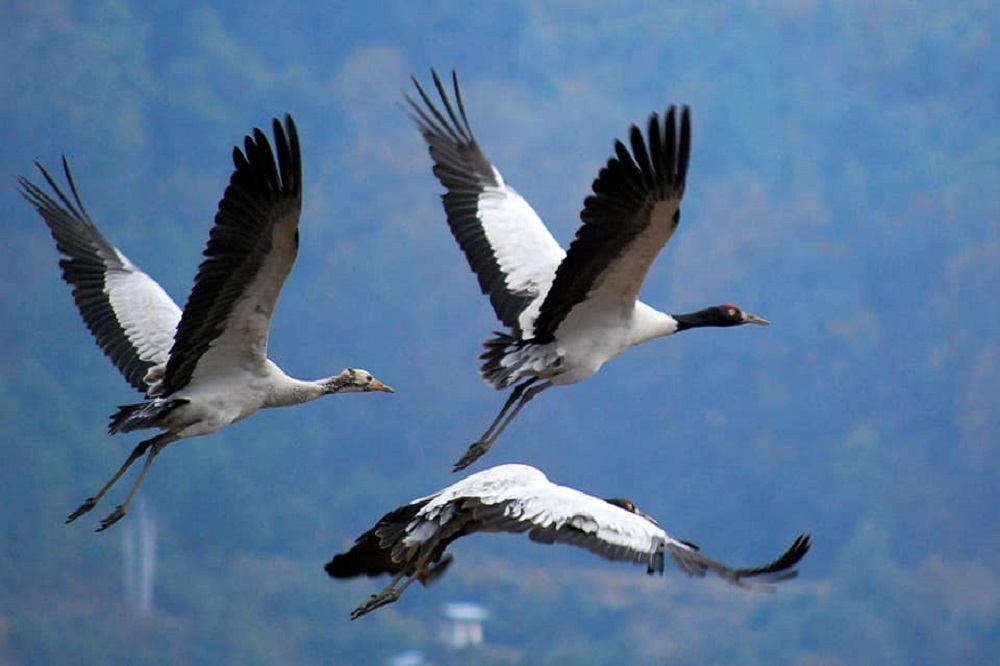
Later explore fascinating Phobjikha valley. This place is the winter home of black necked cranes that migrate from the arid plains in the north to pass winter winter in milder and lower climate. Phobjikha, at an altitude of 2900 m, falls under the district of Wangduephodrang and lies on the periphery of the Black Mountain National Park. The valley boasts two beautiful meandering rivers, Nakay Chhu (Chhu Naap-black water) and Gay Chhu (Chhu Karp-white water).
Also visit Black Neck Crane Information Centre. Situated on the edge of the forest and wetland along the main road of Phobjikha valley, the black-necked crane information Centre has an observation room equipped with high power telescope and spotting scopes for catching the best view of the cranes (Black Necked Cranes can be spotted from Nov-Feb only). The centre also offers display information that outline the natural and cultural history of the area. There is a small gift shop, which sells handicrafts produced by the local people.
Overnight at hotel in Gangtey ( Altitude 3000m)
Day 5: Drive to Paro via Wangduephodran (190 kms, approx. 6/7 hours drive)
After breakfast drive back to Paro descending back down from Dochu La, follow the way back up the dramatic Wang Chhu and Paro Chhu river valleys, before crossing through Paro town towards the north end of the valley.
En route visit Simtokha Dzong, one of the oldest fortresses of the country and known as the place of profound tantric teaching. This dzong now houses a school for the study of the Dzongkha language.
Later in the day after checking into hotel, proceed to visit Ta Dzong, originally built as Watchtower, which now houses National Museum. The extensive collection includes antique thangkha paintings, textiles, weapons & armour, household objects and a rich assortment of natural and historic artifacts.
Then walk down the trail to visit Rinpung Dzong, meaning (“fortress of the heap of jewels”), which has a long and fascinating history. Along the wooden galleries lining the inner courtyard are fine wall paintings illustrating Buddhist lore such as four friends, the old man of long life, the wheel of life, scenes from the life of Milarepa, Mount. Sumeru and other cosmic Mandala.
Evening explore Paro local market.
Overnight at the hotel in Paro. (Altitude 2,280m)
Day 6: Paro
After breakfast embark on an interesting excursion to Taktshang Monastery (approx 5 hours round trip walk). It is one of the most famous of Bhutan’s monasteries, perched on the side of a cliff 900m above the Paro valley floor. Legends say that Guru Rinpoche arrived here on the back of a tigress and meditated at this monastery and hence it is called ‘Tiger’s Nest’. This site has been recognized as a most sacred place and visited by Shabdrung Ngawang Namgyal in 1646 and now visited by all Bhutanese at least once in their lifetime.
OR (if you are not keen on 5 hrs walking tour)
After breakfast, driving excursion to Chelela pass.
Chele la (pass), at an elevation 3,988 meters is considered to be one of the highest motorable passes in Bhutan. About an hour’s drive along a thickly-forested road, is this Pass-a botanical paradise. The pass provides stunning views of the sacred mountain Jomolhari and Jichu Drake. It is also marked by hundreds of prayer flags fluttering in the wind. Here, visitors can see cascades of wild roses, purple and yellow primulas, and swathes of deep blue iris covering the forest floor. In season, the top of the pass bloom with rhododendrons in a variety of colours-pale pink, deep pink, burnt orange, mauve, white and scarlet.
Later en route, walking excursion to Dzongdrakha Goempa. Often called as mini Takshang, Dzongdrakha is a cliff-side temple complex on the western side of the Paro Valley. Four shrines make up the complex, dedicated to Drolma (Tara), Tsheringma (Goddess of Longevity), Guru Rinpoche and the Buddha of the Future, Maitreya. Local oral tradition states that when Guru Rinpoche first visited Bhutan, he came from Nepal, first landing at Drakarpo, and then Dzongdrakha before arriving at Taktshang (Tiger’s Nest) farther north up the valley.
Located approx 20 minute drive from Paro, these temples are built on a cliff above Bondey village but the walk is not as strenuous as Taktshang.
Afternoon drive to the base of Drukgyel Dzong, a ruined fortress where Bhutanese warriors fought Tibetan invaders centuries ago. The snowy dome of sacred Chomolhari, “mountain of goddess” can be seen in all her glory from the approach road to the Dzong.
Along the way, visit the 7th century Kyichu Lhakhang, one of the 108 temples built in the Himalayas by Tibetan King, Songtsen Gampo. The building of this temple marks the introduction of Buddhism in Bhutan.
Evening enjoy Paro city centre.
Overnight at the hotel in Paro. (Altitude 2,280m)
Day 7: Full day Excursion to Haa valley (150km, approx. 6 hours drive)
After breakfast drive to Haa valley, en route taking a short stop at Chelela pass. Located at an elevation of 3,988 meters, Chelela is considered to be one of the highest motorable passes in Bhutan. About an hour's drive along a thickly-forested road, this Pass is a botanical paradise, providing stunning views of the sacred mountain Jomolhari and Jichu Drake. It is also marked by hundreds of prayer flags fluttering in the wind.
Then drive onward to Haa valley.
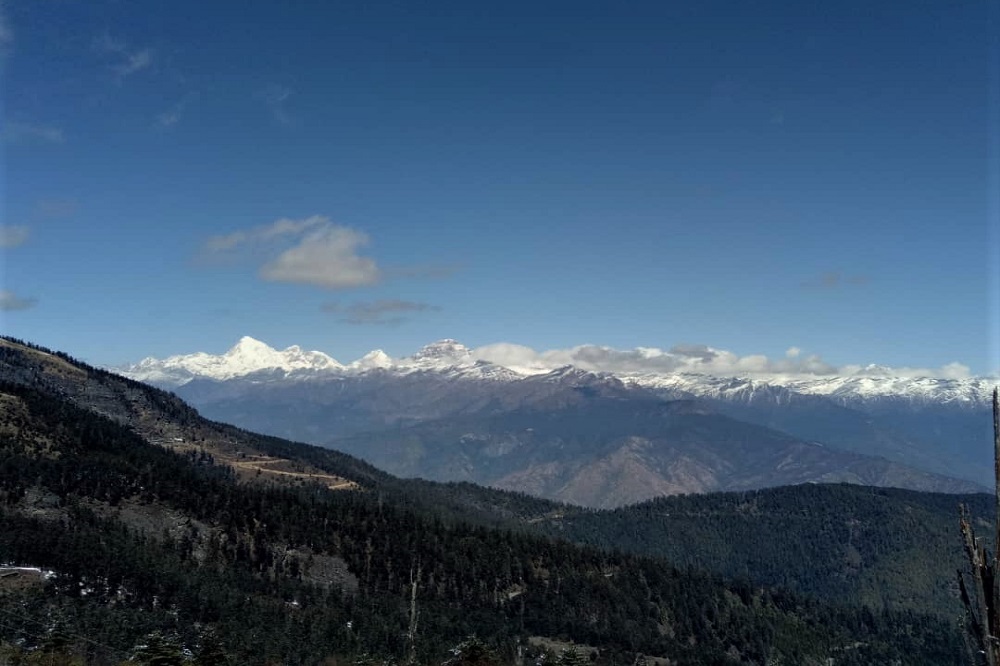
The Haa valley was opened for the first time to foreign tourists in 2002. Also known as the “Hidden-Land Rice Valley”, Haa is culturally rich valley and some of famous sites in this region are : 7th century Lhakhang Karpo (White temple) and Lhakhang Nagpo (Black temple) at the foothills of a venerated three brotherly mountains known as Meri Puensum. The Valley of Haa lies on the western most edge of Bhutan, its northern boundaries with the Chumbi Valley of Tibet, dividing it from the Indian province of Sikkim. Haa is one of the 20 districts or dzongkhags of Bhutan and one of the least populated. Most of its landmass is covered by dense forest and the remainder under fields of wheat and barley, with a little rice towards its lower reaches and the accessible side valleys. Meadows support the raising of yak, cattle, chicken, pigs and horses.
Visit Lhakhang Karpo (White temple), established in the 7th century by Tibetan King Songtsen Gempo. According to legends, a black and white pigeon were released to select the site for temples and the white pigeon landed on the foothills of the three towering mountains worshipped as ‘Rigsum gonpo’ and is where this temple stands today.
Then visit, Lhakhang Nagpo (Black temple), built in 7th century by Tibetan King Songtsen Gempo and situated towards the north of Lhakhang Karpo. Lhakhang Nagpo serves as the seat for the guardian deity ‘Da Do Chen’. The principal relic of the monastery is the Choe-Lung-Truel Sum. Both these temples stand as the guardian sentinels keeping watch at the south entrance of Haa valley.
After Haa valley exploration, evening return to Paro.
Rest of the day at leisure.
Overnight at the hotel in Paro. (Altitude 2,280m)
Day 8: Depart Paro
After breakfast at the hotel, drive to the airport for flight to your onward destination. Our representative will help you with exit formalities and then bid you farewell.
HOTELS IN THIMPHU
HOTELS IN PUNAKHA & WANGDUE
HOTELS IN GANGTEY
HOTELS IN TRONGSA
HOTELS IN BUMTHANG
HOTELS IN MONGAR
HOTELS IN TRASHIGANG
HOTELS IN SAMDRUP JONGKHAR
HOTELS IN PHUENTSHOLING
HOTELS IN HAA
HOTELS IN GELEPHU
HOTELS IN ZHEMGANG
RESTAURANTS IN PARO
RESTAURANTS IN THIMPHU
RESTAURANTS IN PUNAKHA
TOUR ITINERARIES
TREKKING ITINERARIES
SPECIAL INTERESTS TOURS
UNIQUE FESTIVALS & FAIRS
BLOG
